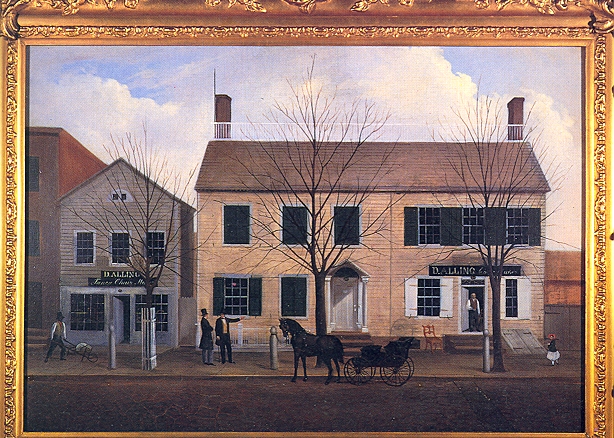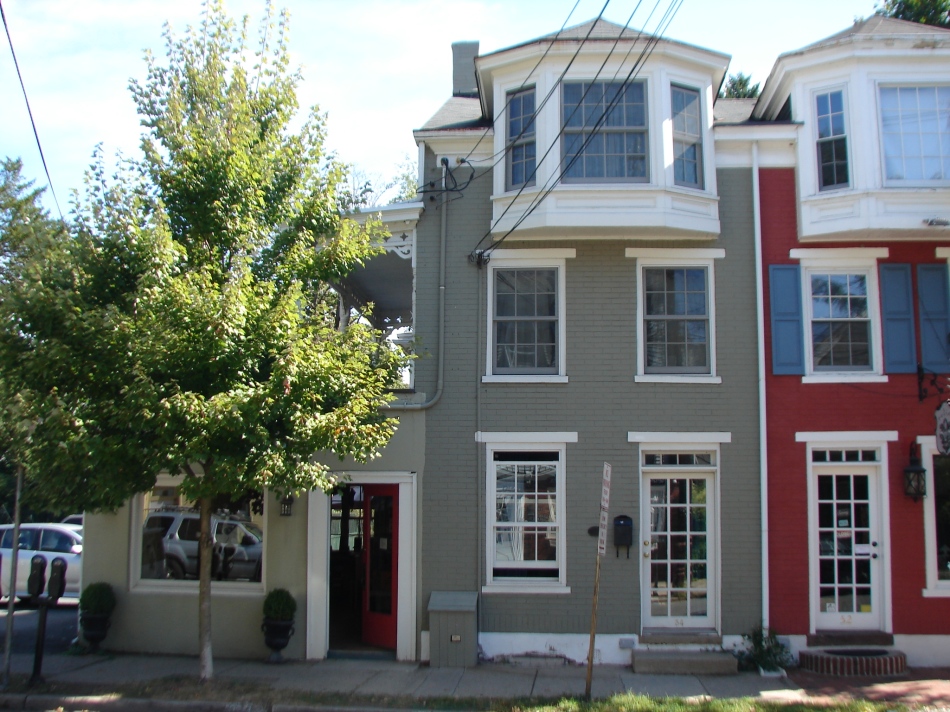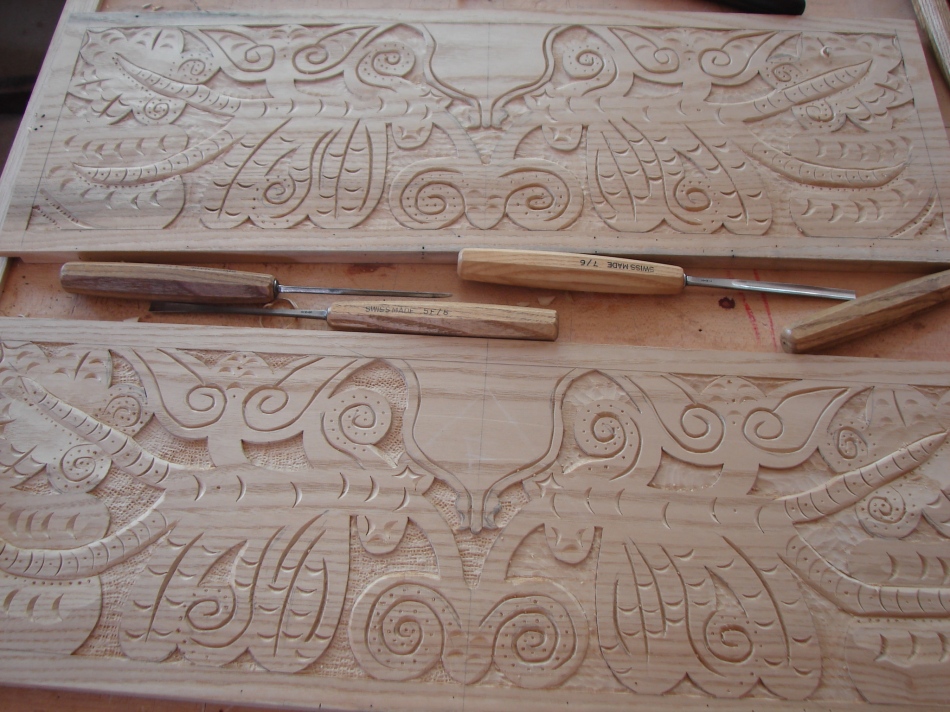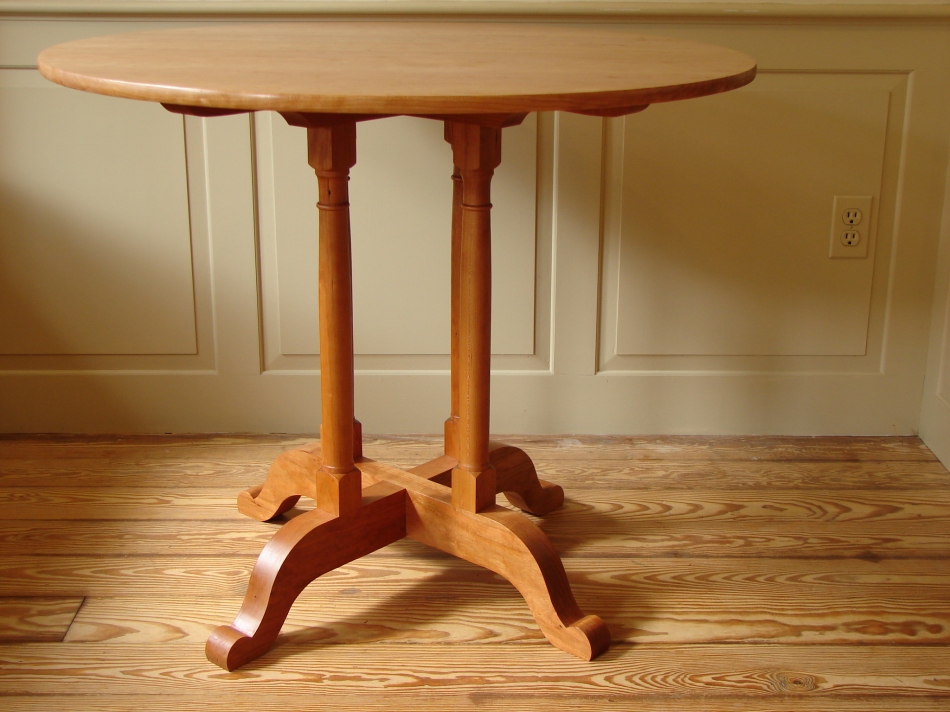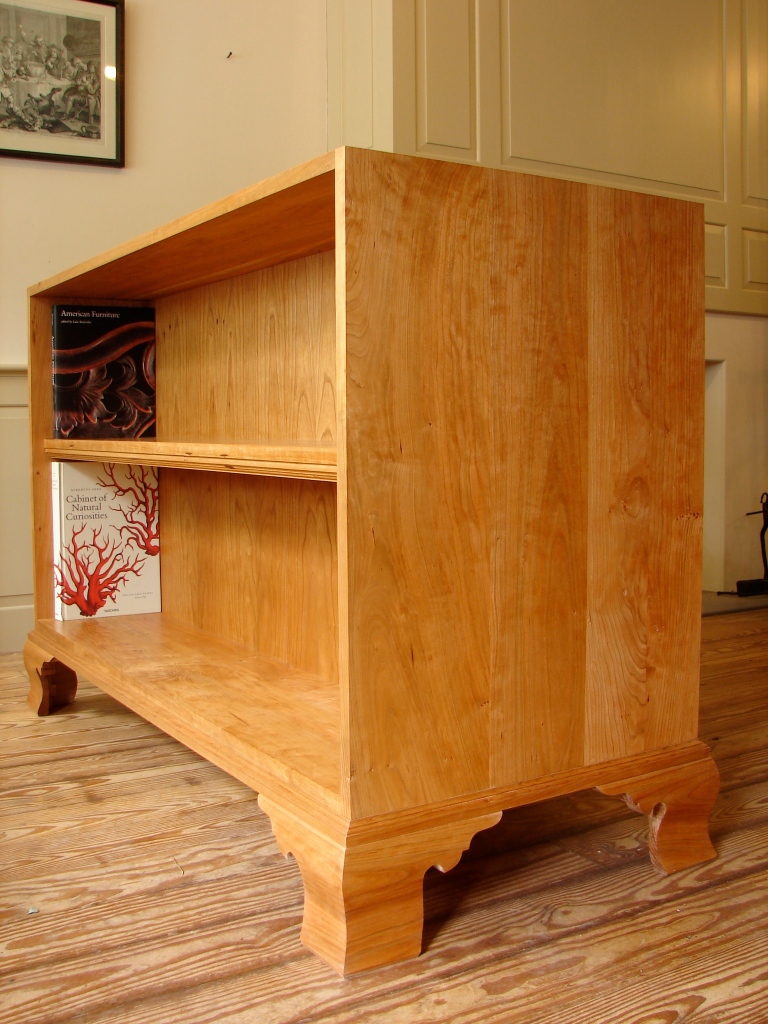Recent Work

 This picture sums up where I am these days. Looking backward and forward, old and new. The Hadley trunk, based on examples from 1695-1725, I made of sassafras and finished with paint and shellac. It rests upon a minimalist and modern white oak breakfast table. The trunk is festooned with an ancient carving pattern complemented by an escutcheon cast from original 17th Century brasses. The corners are nailed like the original.
This picture sums up where I am these days. Looking backward and forward, old and new. The Hadley trunk, based on examples from 1695-1725, I made of sassafras and finished with paint and shellac. It rests upon a minimalist and modern white oak breakfast table. The trunk is festooned with an ancient carving pattern complemented by an escutcheon cast from original 17th Century brasses. The corners are nailed like the original.
The table is restrained, it is all about the form., the only decorations are the figure of the boards with which it is made. The finish is “dry” with a low shine that suits it perfectly. It’s modern and clean but approachable and warm, usable.
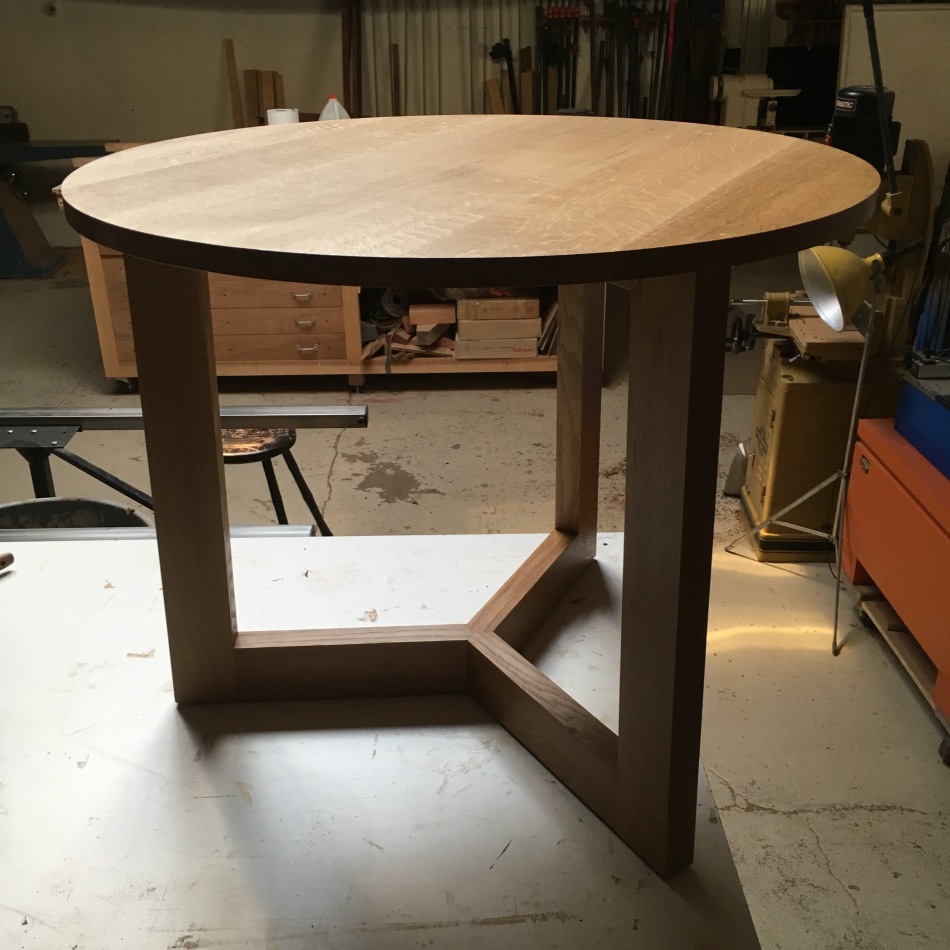 I’ve been bouncing back and forth between styles for the last 13 years, making custom furniture here at Antick in Lambertville, New Jersey. It’s never a straight line, but sometimes things relate to each other in style or species of wood. This year I’ve been making 17th Century case pieces or farm tables. Here are some of them.
I’ve been bouncing back and forth between styles for the last 13 years, making custom furniture here at Antick in Lambertville, New Jersey. It’s never a straight line, but sometimes things relate to each other in style or species of wood. This year I’ve been making 17th Century case pieces or farm tables. Here are some of them.
 This cabinet is based on a piece at Winterthur in Delaware. It is made of walnut with excellent hardware from Londonderry. I really like the turnings and, though it’s hard to see, the x-stretcher between them.
This cabinet is based on a piece at Winterthur in Delaware. It is made of walnut with excellent hardware from Londonderry. I really like the turnings and, though it’s hard to see, the x-stretcher between them.


 This is a farm table I designed in white oak with a plank top.
This is a farm table I designed in white oak with a plank top.
 This valuables cabinet was particularly interesting. It is made of walnut with two figured tombstone paneled doors. Lots of great hardware and moldings.
This valuables cabinet was particularly interesting. It is made of walnut with two figured tombstone paneled doors. Lots of great hardware and moldings.
 Lastly we have another farm table. This one in walnut with a one and a half inch thick top. At nearly 7 feet by 4 feet it is truly a great table.
Lastly we have another farm table. This one in walnut with a one and a half inch thick top. At nearly 7 feet by 4 feet it is truly a great table.

Shopkeep.
This is the shop and warehouse of Duncan Phyfe, on Fulton Street in New York City c.1816. I think that must be his home on the right, otherwise why have it in the painting? Duncan Phyfe was a very successful cabinet maker in the early 19th Century and the first American to have a furniture style named after him, though not in his time. I’d love to have seen the City in this time period–look at all that sky! I also love the person peering out of the attic window.
This is the house, shop, and warehouse of David Alling on Broad Street in Newark, New Jersey c.1835 (attributed to Johann Jenny). David Alling was a tremendously prolific “fancy chair” maker (yeah,that’s a thing) and exporter who made tens of thousands of chairs and shipped them all over the south and mid-west. I love the bare trees in this painting, and all of the details.
And guess what, here’s my house and showroom in Lambertville, New Jersey c.2013. The sign is hidden by the still-leafy tree. It makes me happy to share something with these craftsmen and shop keeps of the past, who lived and worked and made furniture right there in the same place. It’s a rare thing these days for furniture to be designed, made, and sold by the same person in one place.
Ellie’s Trunk
This is a keepsake box for a new born named Ellie. It is a copy of a box made in the Connecticut River Valley in Massachusetts between 1695-1725. Wallace Nutting calls it a trunk in his book Furniture Treasury.
I painted it green to emphasize the symbolism of the the growing vine, and a new life.
The pattern of the carving is an expanded version of the pattern on Hadley chests. In fact, I used the same pattern that I used for Ellie’s parents wedding chest, and it fit the boxes measurements perfectly. I just “grew” the vine to fit the height of the box.
I made the box out of a wide board of sassafras that was re-sawn into half inch thick sides. Sassafras has a wonderful smell and carves well, the original was made from riven oak with a pine lid and bottom. Ellie’s box is joined by half blind and through dovetails. I made another box joined with nails and a rabbet like the original.
The carving on this box is more “developed” than most Hadley chests because it is carved partially in the round, it is still charmingly naive and child like. The ground of the carving has been dressed with punch-work.
Here is a bible box I made in comparison. Ellie’s trunk is 25 1/2″ long, 16 1/4″ wide, and 9 1/2″ high
A place for everything.
Earlier this year I made this “Welsh dresser” for a person in Philadelphia. A Welsh dresser is kind of a catchall phrase here. It usually refers to any number of designs for kitchen storage, work, and display above and bellow. This design has a plate rack, three lockable drawers, two lockable doors and a center opening, sometimes called a kennel.
The monolithic piece is made of curly maple, a grain which causes the wood to shift color from dark to light depending on how the light is shining. Here it has been stained to a warm amber color. The effect is quite beautiful as the sun changes the light in the room throughout the day.
The lower section is a frame and panel construction with pegged mortise and tenon joints. The lipped drawers are made with hand cut half-blind dovetails . Hand carved tombstone panels liven up the doors. Grain and color of each board was carefully considered to give a unified facade. On top there are gently shaped shelves for plates and glasses. It is held together with hand cut dovetails and through wedged mortise and tenons. A carefully matched scalloped valance and crown molding top it all off.
Looking back at 2012
It’s been a long old year here at Antick. It all started with a new customer Mr. G—, an interesting fellow who likes to turn discarded lumber into unusual antiques. This is the first piece, a tall case clock made of old pine book shelves. He then paints or otherwise finishes them himself.
Reproducing a reproduction, again using reclaimed lumber, and a riff on the same form.
I also made a new stick for a cane, it’s ebony carved to resemble blackthorn.
I’ve already posted about this double sided bookcase. Then I made tables in cherry and curly maple.
Another reclaimed lumber chest and a thoroughly modern nixie tube clock out of a solid block of walnut.
A miniature blanket chest with drawer made of reclaimed pine.
Two compound angle dovetail projects in cherry.
A Queen Anne mirror in curly maple, and a Pennsylvania German bench.
This is an architectural model that is also a box, it’s a very cool design and was the first time I have cut a dovetail in plexiglass!
A ship model weathervane and solid wood skull made of bass wood.
More weathervanes, the top one is based on Albert Pinkham Ryder’s painting “the Racetrack”.
More architectural models.
This is a bathroom vanity made of white oak in an old english Elizabethan style. It is almost eleven feet long.
It will be stained quite dark. I love the rhythm of the scrolled cuts at the base and the many levels of mouldings and carving of the facade.
We are wishing for a happy, healthy and prosperous New Year for us all.
Double Sided Cabinet
This is a commissioned book case that I’ve just completed. It is made of cherry, with an oil, shellac and wax finish. It was designed to divid the space between a kitchen and great room and be accessible from both sides, one side is open and the other has doors. The case is quite large, 54″ long 36″ high and 22″ deep.
The case is a good height for a serving station during parties.The shelves accommodate most art books.
Hand cut half-blind dovetails join the sides of the case which sits on a frame supported by ogee bracket feet.


